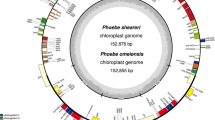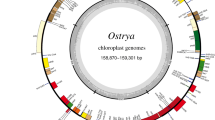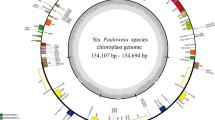Abstract
The genetic relationships of 38 individuals from 13 Elymus tetraploid species, two Pseudoroegneria species and one Hordeum species were examined using polymerase chain reaction-restriction length polymorphism analysis of chloroplast gene regions. The 13 Elymus species contain SH and SY genomes with either a single spikelet or multiple spikelets per rachis node. The Pseudoroegneria and Hordeum species contain an S genome with single spikelet per rachis node and an H genome with multiple spikelets per rachis node, respectively. Four chloroplast gene regions, trnD-trnT intron, trnK [tRNA-Lys (UUU) exon1]–trnK [tRNA-Lys (UUU) exon2], trnC-trnD, and rbcL were amplified with specific primers and subsequently digested with up to 16 different restriction enzymes. Interspecific variation was detected in the four regions. A dendrogram based on similarity matrices using the unweighted pair group method with arithmetic average algorithm separated the 38 individuals into two distinct groups: the Elymus and Pseudoroegneria species as one group and Horduem as a second group. This result corresponded well with previous findings, and strongly suggested that a Pseudoroegneria species is the maternal donor to tetraploid Elymus species. Unlike previous studies using nuclear genes, the chloroplast DNA used in this study could not clearly separate the SY-genome species from SH-genome species. No clear separation between the species with a single spikelet per rachis node and the species with multiple spikelets per rachis node was found. Intra-specific variation was detected for the species studied. These observations provide molecular evidence for the highly diverse nature of the Elymus gene pool based on morphological characteristics.






Similar content being viewed by others
References
Baum BR (1983) A phylogenetic analysis of the tribe Triticeae (Poaceae) based on morphological characters of the genera. Can J Bot 61:518–535
Bothmer R von, Flink J, Lanström T (1986) Meiosis in interspecific Hordeum hybrids. I. Diploid combinations. Can J Genet Cytol 28:525–535
Dewey DR (1980) Cytogenetics of Agropyron ugamicum and six of its interspecific hybrids. Bot Gaz 141:305–312
Dewey DR (1984) The genomic system of classification. A guide to intergeneric hybridization with the perennial Triticeae. In: Gustafson JP (ed) Gene manipulation in Plant Improvement. 16th Stadler Genetics Symposium. Plenum, New York, pp 209–280
Grant V (1981) Plant speciation. Columbia University Press, New York
Hauser LA, Crovello TJ (1982) Numerical analysis of genetic relationships in Thelypodieae (Brassicaceae). Syst Bot 7:249–268
Hitchcock AS (1951) Tribe 3. Hordeae. In: Manual of the Grasses of the United States. U.S. Government Printing Office, Washington, DC, pp 230–280
Hsiao C, Chatterton NJ, Asay KH, Jensen KB (1995) Phylogenetic relationships of the monogenomic species of the wheat tribe Triticeae (Poaceae), inferred from nuclear rDNA (internal transcribed spacer) sequences. Genome 38:211–223
Jaaska V (1992) Isoenzyme variation in the grass genus Elymus (Poaceae). Hereditas 117:11–22
Jensen KB (1990) Cytology and taxonomy of E. grandiglumis, E. alatavicus, and E. batalinii (Poaceae: Triticeae). Genome 33:668–673
Jensen KB, Salomon B (1995) Cytogenetics and morphology of Elymus panormitanus var. heterophyllus (Keng) A. Löve and its relationship to Elymus panormitanus (Poaceae: Triticeae). Int J Plant Sci 156:731–739
Jensen KB, Hatch SL, Wipff JK (1992) Cytology and morphology of Pseudoroegneria deweyi (Poaceae: Triticeae): a new species from the foothills of the Caucasus Mountains (Russia). Can J Bot 70:900–909
Jones TA, Redinbaugh MG, Zhang Y (2000) The Western Wheatgrass chloroplast genome originates in Pseudoroegneria. Crop Sci 40:43–47
Junghans H, Metzlaff M (1990) A simple and rapid method for the preparation of total plant DNA. Biotechniques 8:176
Kellogg EA, Appels R (1995) Intraspecific and interspecific variation in 5S RNA genes are decoupled in diploid wheat relatives. Genetics 140:325–343
Kellogg EA, Appels R, Mason-Gamer RJ (1996) When gene tree tell different stories: the diploid genera of the Triticeae (Gramineae). Syst Bot 21:321–347
Keng YL (1959) Flora Illustralis Plantarum Primarum Sinicarum (Garmineae). Science Press, Beijing
Leitch B, Bennett MD (1998) Polyploidy in angiosperms. Trends Plant Sci 2:470–476
Löve A (1984) Conspectus of the Triticeae. Feddes Rep 95:425–521
Löve A, Connor HE (1982) Relationships and taxonomy of New Zealand wheatgrasses. N Z J Bot 20:169–186
Lu BR (1991) Intergeneric crosses of Psathyrostachys huashanica with Elymus spp. and cytogenetic studies of the hybrids with E. tsukushiensis (Poaceae, Triticeae). Nord J Bot 11:27–32
Lu BR (1993) Biosystematic investigations of asiatic wheatgrasses—Elymus L. (Triticeae: Poaceae). Ph.D. thesis, Swedish University of Agricultural Sciences, Alnarp, Sweden
Lu BR (1994) The genus Elymus L. in Asia. Taxonomy and biosystematics with special reference to genomic relationships. In: Wang RRC, Jensen KB, Jaussi C (eds) Proceedings of the 2nd International Triticeae Symposium, Logan, UT, pp 219–233
Lu BR, Bothmer R von (1990) Intergeneric hybridization between Hordeum and Asiatic Elymus. Hereditas 112:109–116
Lu BR, Salomon B (1992) Differentiation of the SY genomes in Asiatic Elymus. Hereditas 116:121–126
Mason-Gamer RJ (2001) Origin of North America Elymus (Poaceae: Triticeae) allotetraploids based of granule-bound starch synthase gene sequences. Syst Bot 26:757–758
Mason-Gamer RJ, Kellogg EA (1996a) Chloroplast DNA analysis of the monogenomic Triticeae: phylogenetic implications and genome-specific markers. In: Jauhar PP (ed) Methods of genome analysis in plants. CRC Press, Boca Raton, pp 301–325
Mason-Gamer RJ, Kellogg EA (1996b) Testing for phylogenetic conflict among molecular data sets in the tribe Triticeae (Gramineae). Syst Biol 45:524–545
Mason-Gamer RJ, Kellogg EA (2000) Phylogenetic analysis of the Triticeae using the starch synthase gene, and a preliminary analysis of some North American Elymus species. In: Jacobs SWL, Everett J (eds) Grasses: systematics and evolution. CSIRO Publishing, Collingwood, Victoria, Australia, pp 102–109
Mason-Gamer RJ, Orme NL, Anderson CM (2002) Phylogenetic analysis of North American Elymus and the monogenomic Triticeae (Poaceae) using three chloroplast DNA data sets. Genome 45:991–1002
Masterson J (1994) Stomatal size in fossil plants: evidence for polyploidy in majority of angiosperms. Science 264:421–424
Melderis A, Humphries EJ, Tutin TG, Heathcote SA (1980) Tribe Triticeae Dumort. In: Tutin TG, et al (eds) Flora Europaea, vol 5. Cambridge University Press, Cambridge, pp 190–206
Nevski SA (1934) Hordeae Benth. In Komarov VL, Roshevits RY, Shishkin BK (eds) Flora URSS II. Leningrad, pp 590–728
Petersen G, Seberg O (1997) Phylogenetic analysis of the Triticeae (Poaceae) based on rpoA sequence data. Mol Phylogenet Evol 7:217–230
Redinbaugh MG, Jones TA, Zhang Y (2000) Ubiquity of the St chloroplast genome in St-containing Triticeae polyploids. Genome 43:846–852
Rohlf FJ (1993) Numerical taxonomy and multivariate analysis system. Version 1.80. Exeter Software, Setauket, NY
Salomon B, Lu BR (1992) Genomic groups, morphology, and sectional delimitation in Eurasian Elymus (Poaceae, Triticeae). Plant Syst Evol 180:1–13
Soltis DE, Soltis PS (1993) Molecular data and the dynamic nature of polyploidy. Crit Rev Plant Sci 12:243–273
Sun G (2002) Interspecific polymorphism at non-coding regions of chloroplast, mitochondrial DNA and rRNA IGS region in Elymus species. Hereditas 137:119–124
Sun GL, Salomon B, Bothmer R von, (1997) Analysis of tetraploid Elymus species using wheat microsatellite markers and RAPD markers. Genome 40:806–814
Svitashev S, Salomon B, Bryngelsson T, Bothmer R von (1996) A study of 28 Elymus species using repetitive DNA sequences. Genome 39:1093–1101
Svitashev S, Bryngelsson T, Li X, Wang RRC (1998) Genome-specific repetitive DNA and RAPD markers for genome identification in Elymus and Hordelymus. Genome 41:120–128
Tzvelev NN (1976) Tribe 3. Triticeae Dumort. In:Fedorov AA (ed) Poaceae URSS. Navka, Leningrad, pp 147–181
Acknowledgements
We thank Dr. B. Salomon at The Swedish University of Agricultural Sciences and the Regional Plant Introduction Station, USDA, for kindly supplying the seeds used in this study. This research was supported with grants from NSERC, a Senate Research Grant and the Student Employment Experience Program (SEEP) at Saint Mary's University.
Author information
Authors and Affiliations
Corresponding author
Additional information
Communicated by H.F. Linskens
Rights and permissions
About this article
Cite this article
McMillan, E., Sun, G. Genetic relationships of tetraploid Elymus species and their genomic donor species inferred from polymerase chain reaction-restriction length polymorphism analysis of chloroplast gene regions. Theor Appl Genet 108, 535–542 (2004). https://doi.org/10.1007/s00122-003-1453-3
Received:
Accepted:
Published:
Issue Date:
DOI: https://doi.org/10.1007/s00122-003-1453-3




